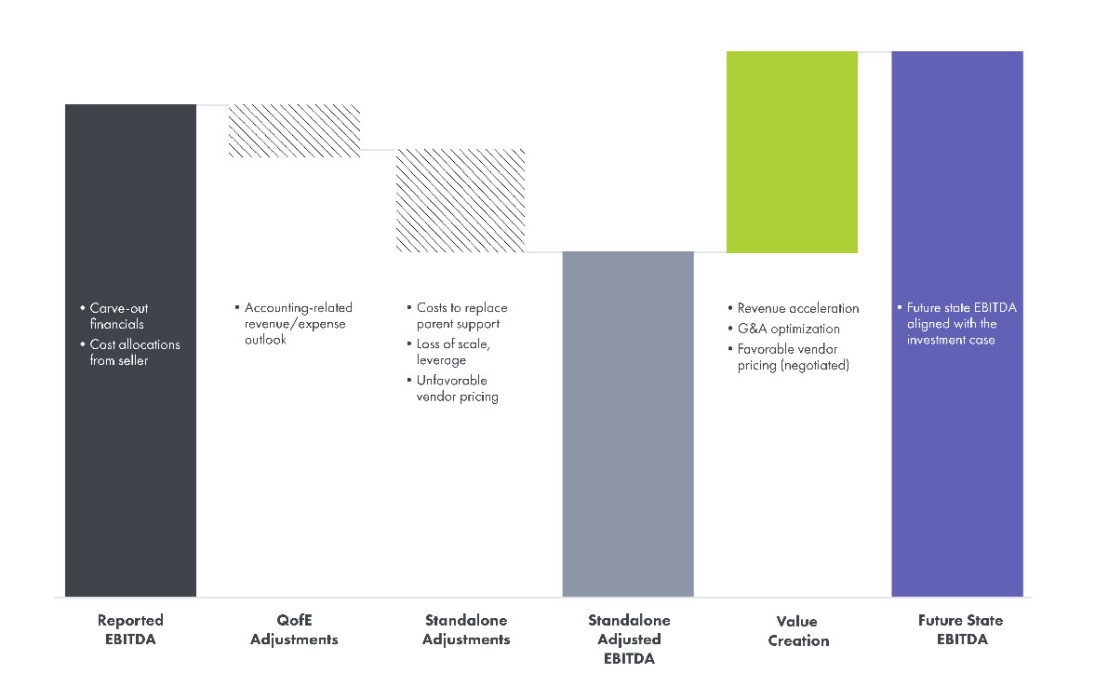The 4-Step Framework: Creating Value in a
Carve-Out
Meet the Author
Value creation is fundamental to every private equity investment deal, and a carve-out is no exception. However, the complexity of the carve-out, especially if not well-executed, can overshadow value creation goals — resulting in below-target value realization and perhaps sub-optimal returns on investment. But this doesn’t have to be the case; PE sponsors who are laser-focused on value creation planning and understand how to navigate the complexity of carve-outs will be well-prepared to meet, if not exceed, their value creation targets.
“There is significant value in a carve-out, but complexity makes realization challenging.”
While the attractive valuation and value creation potential will likely excite the deal team from the get-go, carve-outs can be easily thwarted by unexpectedly high one-time and/or recurring costs from transitional services, elevated stress due to reckless planning of separation, and stand-up efforts throughout the carve-out process that distract from delivering business results.
Here are four steps to ensure PE firms don’t get tripped up in their value creation plans:
1. Develop value creation targets pre-deal as part of investment case
The deal team must develop an early value creation strategy by identifying and assigning initial value creation targets — while analyzing the stand-alone operating model and costs of the carve-out business. Typically, the carve-out is entangled with the parent seller operations, and it’s possible that the reported financial (if available) does not reflect the true cost of the business operations. Therefore, it’s essential to estimate the costs of running the business as an independent and stand-alone entity (though this stand-alone cost calculation assumes that the business operating model is more-or-less equivalent to how the business operated in the parent environment).
This is where the deal team must layer the initial value creation targets on top of the stand-alone costs baseline, reflecting the accurate financial impact of the value creation objectives — as articulated in the investment case below.

2. Explicitly communicate value creation expectations to the management team
As soon as the management team is organized, which typically occurs immediately after closing, the deal team should share their investment vision, objectives, and value creation expectations. At the same time, they should validate and refine the value creation targets and stand-alone cost baseline based on the feedback from the management team. The validation should begin with the management team developing a future state operating model that should align with the PE firm’s investment objectives.
3. DEVELOP FUTURE STATE OPERATING MODEL THAT SERVES AS VALUE CREATION BLUEPRINT
The future state operating model serves as the blueprint to the overall carve-out process, including separation planning, TSA exit, stand-up plans, and more. The design choices should depend on the weight of the separation efforts, the TSA timeline, and the management team’s experience in carve-out stand-up efforts to ensure that there is no significant business disruption risk in the process.
With that said, value creation objectives should be top-of-mind in designing the future state operating model, as the blueprint will govern the timing and the magnitude of value creation.
“Whether the carve-out will be a ‘lift and shift and fix’ or bold re-design will inform the value creation targets and roadmap.”
4. DEVISE ORGANIZED VALUE CREATION PROGRAM TO ACHIEVE THE TARGETS
While carve-outs require an extensive focus on post-close business stabilization and cost management — as should be reflected in the devised future state operating model — a value creation program should certainly not be overlooked. A dedicated value creation team should be established, either as part of the overall Separation Management Office (SMO) or as a separate group working closely with the SMO.
The ideal value creation team should be comprised of management teams and experts from across disciplines who are equipped to assess and identify value creation opportunities, ensure that value creation is embedded in the separation plans, and ensure that acceleration levers are considered throughout the stand-up process. This combination of broad and in-depth experience is essential to ensuring that PE firms maximize value from their carve-out deals — instead of letting it go to waste.
“Value creation shouldn’t wait. Rather, it should complement the stand-up.”
The bottom line? Carve-outs provide attractive opportunities for PE firms to unlock significant value from a business with untapped potential. However, implementing a robust strategy and organized process — backed by qualified deal, management, and value creation teams — is table stakes for realizing these opportunities. In other words, a tight partnership between the future state operating model and the value creation process is critical; when they align, PE firms will be well-equipped to navigate the carve-out complexities and maximize value.



